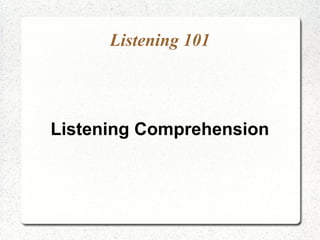Upper primary listening comprehension (vis)
•Download as PPT, PDF•
0 likes•428 views
Report
Share
Report
Share

Recommended
More Related Content
Viewers also liked
Viewers also liked (16)
New ms1 file 5 environment according to atf & aef competencies

New ms1 file 5 environment according to atf & aef competencies
2 g & evaluation of the situation of inegration

2 g & evaluation of the situation of inegration
Evaluation assessment & 2g curriculum a pril 26 2016

Evaluation assessment & 2g curriculum a pril 26 2016
2n meeting & workshop 2 g & curriculum competences october 8th 2016 ...

2n meeting & workshop 2 g & curriculum competences october 8th 2016 ...
Meeting & workshop test report & remedial work february 2016

Meeting & workshop test report & remedial work february 2016
1st meeting october 18th 2016 2 g and teaching values

1st meeting october 18th 2016 2 g and teaching values
Teaching grammar aeltt meeting algiers may 21 st2016

Teaching grammar aeltt meeting algiers may 21 st2016
Similar to Upper primary listening comprehension (vis)
Similar to Upper primary listening comprehension (vis) (20)
Your research as elevator pitch - nbic conference 2013

Your research as elevator pitch - nbic conference 2013
Brain rules 1, 2, 3: Put neuroscience in your presentations

Brain rules 1, 2, 3: Put neuroscience in your presentations
More from Designlab Innovation
More from Designlab Innovation (20)
Languagelab 3.4 - Master Present & Past Continuous Verbs

Languagelab 3.4 - Master Present & Past Continuous Verbs
Youth Entrepreneurship Skills (YES) Program by Designlab

Youth Entrepreneurship Skills (YES) Program by Designlab
Languagelab 25.1 - Master Subject Verb Rules and Exceptions

Languagelab 25.1 - Master Subject Verb Rules and Exceptions
Upper primary listening comprehension (vis)
- 2. Learning Objectives To understand the principles in aceing Listening Comprehension. To learn listening techniques that are able to help achieve a better score.
- 3. Introduction Recall that our brain recall facts best if they are visualised. Visualisation is about converting facts into pictures. Even better, pictures that are in motion, linked and form a story.
- 4. Listening Comprehension Test 1 Remember these words: House Man and Woman Passing Truck Two Children Neighbours dog Shed Swing Red Bricks Orange Gate Yellow Car Porch You will be asked questions about them later.
- 5. Listening Comprehension Test 2 There was a house with red bricks, with a shed for man and woman and a swing for two children. There was also an orange gate and a yellow car at the porch. Whenever, there's a passing truck, the neighbour's dog would bark.
- 6. Listening Comprehension Skill Applying the principle of visualisation to listening comprehension, you cannot just listen passively. When you are told a story, you must listen actively. Using visualisation, you must actively form pictures in your mind that connects all the key scenes together, linking and forming a story. Draw to help you to remember!
- 8. Discussion What is the method you use to absorb as much information as possible? How do you ensure that no details are missed? Why do you think you need to learn about the technique of listening comprehension?
- 9. Discussion What is the method you use to absorb as much information as possible? Multi-sensory technique How do you ensure that no details are missed? Listen, see in the mind, draw or write. Why do you think you need to learn about the technique of listening comprehension? So we will not miss out on any detail and get most or all of our answers correct.
- 10. Now it's your turn! A listening comprehension will be played. Your job is to practice active listening and visualise the story. Draw the key scenes – remember KISS: Keep it Sweet and Simple. You will be asked questions about these pictures like in a typical listening comprehension exericse.
- 11. In Summary Listening Comprehension requires active listening. Visualisation helps us to keep the story's scenes alive in our mind by picturing them. Drawing the key scenes help us to recall facts about them easier and faster later.
